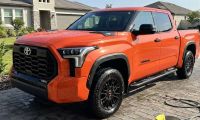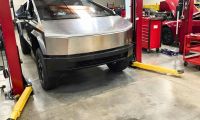When Your Tesla Battery Reaches 0%
If you are driving and your Tesla runs out of battery, what happens? Is it the same as if you have a gas car, and you run out of gas?
Tesla navigation is very accurate and will tell you what % you will be at when you get to a destination. Elevation, wind, and climate are taken into account.
First off, even when you get to 0%, your Tesla can still drive a few more miles. In fact, even for newer models of Tesla vehicles, there are reports that you can go up to 20 miles or more.
If, for whatever reason, you've reached a point that your car can't drive anymore, then you must realize this.
- You cannot tow a Tesla on its wheels due to regenerative braking
- You must put your vehicle in jack mode and then tow mode - this is done through the center console after pressing down the brake: Controls > Service > JackMode
- Next, to put in Tow mode: Controls > Service > Towing > Tow Mode
- Tesla roadside assistance will help, and you can contact them through the Tesla App.
At a service center, Tesla will help restart your battery The most important thing is to always follow the navigation for your Tesla vehicle to the nearest Supercharger or to your home where you can charge. This is most important for not letting your battery get to 0%.
You may also be interested in:
- Tesla sells 3x all other automakers combined
- Tesla Model 3 Dethrones Toyota Camry
- Elon Musk drops mind-blowing product teaser
Tesla owner drives over 18 miles after hitting 0% on his battery:https://t.co/E3acDe6SUu$TSLA @Tesla @torquenewsauto #batteries #evs #charge pic.twitter.com/yweMoaYwA8
— Jeremy Noel Johnson (@AGuyOnlineHere) November 24, 2023
What Other Options Are There to Not Get to 0% Battery?
There are many options to not get to 0% battery. The first option is that there are other charging networks besides Tesla's Supercharger network.
You can find a ChargePoint or other charger nearby using the EV Structure or ChargePoint app for your phone. That would be the first thing to try if your battery is low and there isn't Tesla Super Charging available anywhere.
The next is having a stationary battery storage unit in your trunk or somewhere in your car that you can use in an emergency. There is a case of a user letting his Model S run out of battery, and he had a backup batter unit in the trunk of his car. He had a Tesla adapter and a cable and turned on his portable generator.
Once he got the generator grounded, he attached the cable and adapter to it, with the Tesla charger, and plugged it into his vehicle. The charge point became green and gave him about 1.6 kW. As time went on and the vehicle got warm, he got 3.6 kW.
This isn't quite at most level 2 chargers, but is still pretty good. After about 20 minutes, he got a few % of range added to his car and could take his car to a charger or elsewhere. You can see more information about that in this video:
It's good to test a spare battery unit before you are stranded. I'd recommend taking an EcoFlow unit or something else and hooking it up and plugging it in to your Tesla vehicle to see if you can get a charge from it. That way, you know what to do if you run out of a charge.
I personally don't have a home charger and have never had an issue with running out of charge. I simply understand the Tesla navigation and make sure I always have enough % left in my battery before going to a public charger.
What would you do if your Tesla got to 0% battery? Would you get a portable battery to put in your trunk?
Tesla "Active Hood" will protect pedestrians and cyclists from head injuries, which will save lives:https://t.co/rXOewVbhOD$TSLA @Tesla @torquenewsauto #safety #model3 #activehood pic.twitter.com/OgrgRyhbqS
— Jeremy Noel Johnson (@AGuyOnlineHere) November 27, 2023
In Related News: Tesla Model Y is best-selling vehicle in 2022 For more information, see this video from jeremyjudkins
Leave your comments below, share the article with friends and tweet it out to your followers.
Jeremy Johnson is a Tesla investor and supporter. He first invested in Tesla in 2017 after years of following Elon Musk and admiring his work ethic and intelligence. Since then, he's become a Tesla bull, covering anything about Tesla he can find, while also dabbling in other electric vehicle companies. Jeremy covers Tesla developments at Torque News. You can follow him on Twitter or LinkedIn to stay in touch and follow his Tesla news coverage on Torque News. Image Credit, Evannex, Screenshot












Comments
I simply do not understand
Permalink
I simply do not understand how this happens. Surely they had a 'granny charger' cable (one that permits a charge - albeit rather slow at about 6 miles of added range per hour of charging) on board? Doesn't *every* EV driver..? You, know, 'just in case'? If so, all they'd have to do is knock on the door of some hapless local resident and ask to plug in for an hour or so... Done it at least twice in my early EVing 'career' whilst experimenting with DIY conversions and - after the householder had recovered from falling about laughing, they were more than happy to oblige - and neither would take any money either!